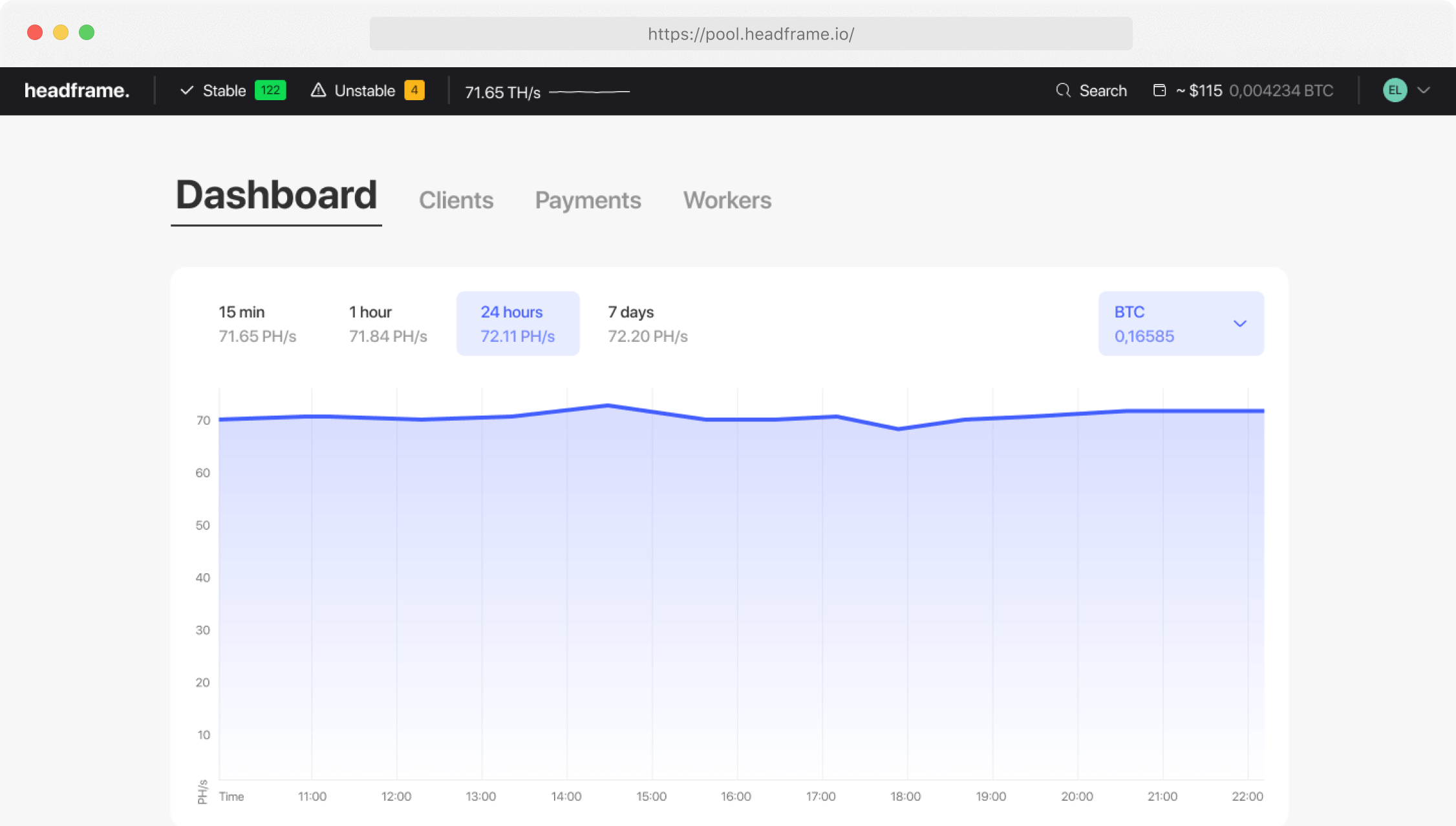Prospects for Using Renewable Energy in Mining Pools
The use of renewable energy sources in mining pools is becoming increasingly relevant as the cryptocurrency industry grows and energy consumption increases. Cryptocurrency mining requires significant energy expenditures, raising concerns about the environmental impact and economic sustainability of mining operations. Let’s explore the prospects and opportunities of using renewable energy in mining pools, as well as the advantages and challenges associated with this transition.
Earn more money with Headframe
Join a mining pool and get the best profitability in mining. Already more than 10,000 miners trust Headframe.
Cost Reduction
One of the primary reasons renewable energy sources are becoming attractive for mining pools is the drive to reduce electricity costs. Traditional energy sources, such as coal and natural gas, are subject to price fluctuations and can be expensive. In contrast, renewable energy sources like solar, wind, and hydroelectric power provide more stable and predictable electricity costs. This allows mining pools to reduce operational expenses and enhance their economic sustainability.
Environmental Sustainability
Environmental sustainability is also a key factor driving the transition of mining pools to renewable energy sources. The high energy consumption of cryptocurrency mining has a significant environmental impact, including CO2 emissions and other pollutants. Using renewable energy helps reduce the carbon footprint of mining operations and lessen their negative impact on the environment. This improvement in environmental sustainability enhances the reputation of mining pools, making them more attractive to participants and investors who are increasingly concerned about environmental issues.
Technological Innovations
Technological innovations play a crucial role in integrating renewable energy into mining pools. Modern technologies, such as efficient solar panels, advanced wind turbines, and hydroelectric systems, significantly increase the production of renewable energy. Implementing these technologies in mining pools ensures stable and reliable energy supply, which is critical for the continuous operation of mining equipment. Additionally, advanced energy management technologies help optimize energy use and reduce excess costs.
Economic Incentives and Government Support
Economic incentives and government support also play a significant role in the development of renewable energy for mining pools. Many countries and regions offer various incentives and subsidies for companies using renewable energy sources. These can include tax benefits, research and development grants, and direct subsidies for the installation and operation of renewable energy systems. Such incentives make the transition to renewable energy more attractive and economically viable for mining pools.
Social Responsibility and Public Opinion
Social responsibility and public opinion also influence the decision of mining pools to transition to renewable energy. Public opinion and consumer preferences are increasingly favoring companies that demonstrate a commitment to sustainable development and environmental responsibility. Mining pools that actively use renewable energy can gain significant advantages in terms of improved reputation and support from the public and market participants.
Infrastructure and Technical Challenges
Infrastructure challenges and technical complexities are among the main obstacles to the widespread use of renewable energy in mining pools. Creating and maintaining infrastructure for the production and distribution of renewable energy requires substantial investments and technical expertise. Moreover, renewable energy sources like solar and wind can be subject to seasonal and weather variations, necessitating additional measures to ensure a stable energy supply. Investments in research and development, as well as collaboration with technical specialists and energy companies, can help overcome these challenges and successfully integrate renewable energy.
Financial Aspects
Financial aspects also play a critical role in the decision to transition to renewable energy. The initial costs of installing and setting up renewable energy systems can be high, requiring significant investments. However, in the long run, the use of renewable energy can lead to substantial savings by reducing electricity costs and dependence on traditional energy sources. Developing and adhering to budgets, controlling income and expenses, and attracting investments and subsidies can help mining pools overcome financial barriers.
Regulatory Aspects
Regulatory aspects are important for the successful integration of renewable energy. Different countries and regions have their own laws and regulations regarding the use of renewable energy and cryptocurrency mining. Compliance with all legislative requirements and active interaction with regulators help avoid legal issues and ensure the legitimacy of operations. Transparency and adherence to norms also strengthen the trust of participants and investors, contributing to stability and revenue growth.
Educational Initiatives
Educational initiatives and upskilling participants in mining pools also play a vital role in the successful integration of renewable energy. Training miners in new methods and technologies helps improve their skills and knowledge, leading to more efficient work. Educational programs and training sessions help pool participants better understand and use modern technologies to optimize their operations. This promotes more responsible and informed participation in mining operations, enhancing their overall efficiency and stability.
Partnerships and Collaborations
Partnerships and collaborations with other mining pools and energy companies can also facilitate the successful integration of renewable energy. Combining efforts and sharing knowledge and resources help accelerate the development and implementation of new technologies. Partnership relationships foster the creation of a global ecosystem where innovations can quickly spread and adapt to various conditions. This improves the overall efficiency and sustainability of mining operations.
In conclusion, the prospects for using renewable energy in mining pools are promising and can lead to significant improvements in the efficiency, sustainability, and economic benefits of mining operations. Reducing electricity costs, improving environmental sustainability, technological innovations, economic incentives, social responsibility, overcoming infrastructure and technical challenges, financial management, regulatory compliance, educational initiatives, and partnerships all play a critical role in the successful integration of renewable energy into mining pools. Understanding and applying these strategies help mining pools effectively address challenges and achieve long-term success in the cryptocurrency industry, creating a sustainable and inclusive ecosystem for all participants.


